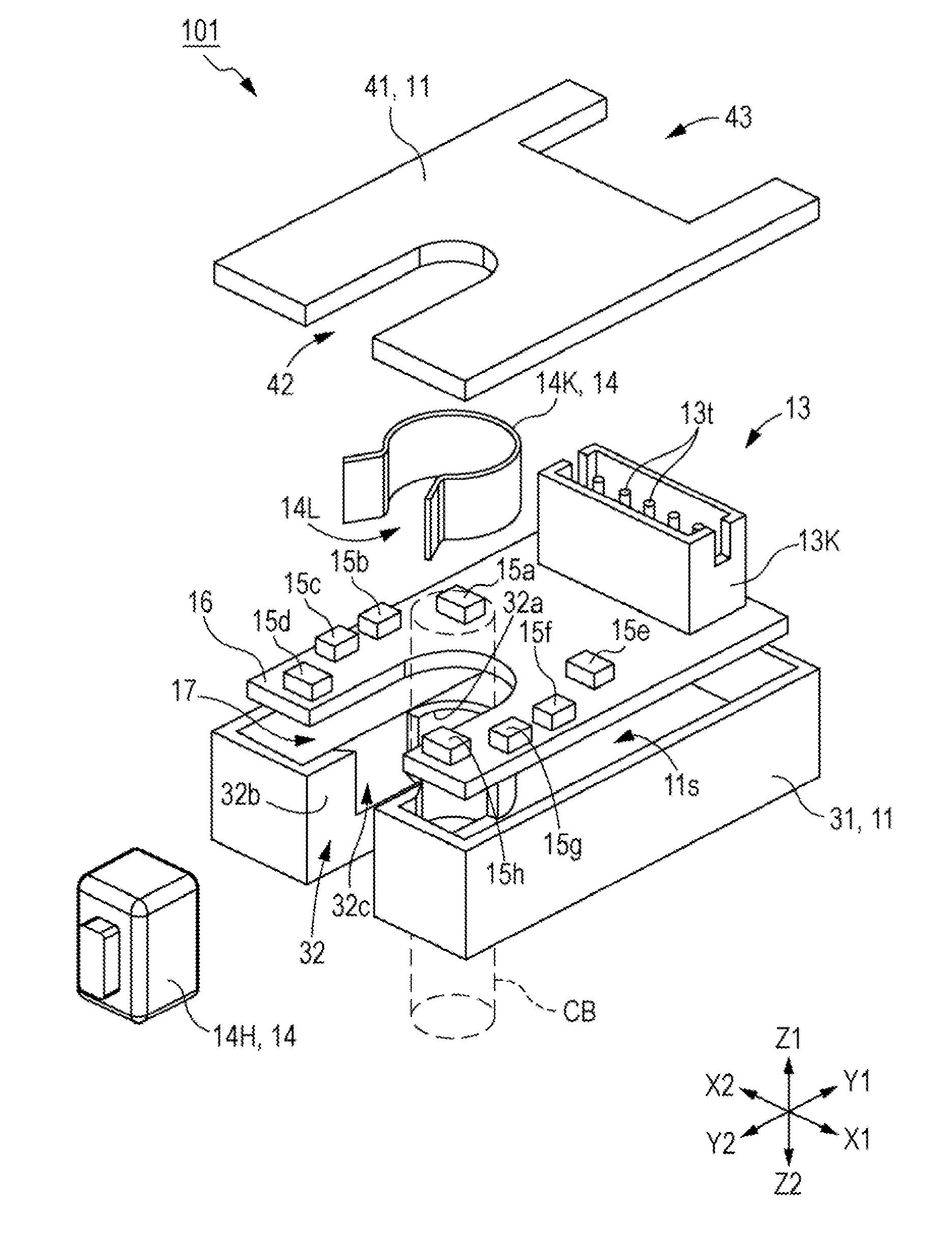Current sensor
a current sensor and current path technology, applied in the field of current sensor, can solve the problems of inability to obtain stable detection values of magnetoelectric conversion elements (cb>15/b>, cb>25/b>), and the size of the current sensor cannot be reduced any further, so as to achieve the effect of further reducing the effect of external magnetic fields from neighboring current paths
- Summary
- Abstract
- Description
- Claims
- Application Information
AI Technical Summary
Benefits of technology
Problems solved by technology
Method used
Image
Examples
first embodiment
[0044]FIG. 1 is a disassembled perspective view illustrating a current sensor 101 according to a first embodiment of the present invention. FIG. 2 is a perspective view of the current sensor 101 according to the first embodiment of the present invention. FIG. 3 is a plan view for describing the current sensor 101 according to the first embodiment of the present invention, illustrating a wiring board 16 as viewed from the Z1 side shown in FIG. 1. FIG. 14 is a layout diagram for describing a comparative example in comparison with the current sensor 101 according to the first embodiment of the present invention, illustrating magnetoelectric conversion elements according to a comparative example 3 in comparison with the layout of magnetoelectric conversion elements 15 in FIG. 3.
[0045]The current sensor 101 according to the first embodiment is configured including multiple magnetoelectric conversion elements 15 which detect magnetism generated when a current flows through a current path ...
second embodiment
[0073]FIG. 9 is a disassembled perspective view illustrating a current sensor 102 according to a second embodiment of the present invention. FIG. 10 is a plan view of the current sensor 102 according to the second embodiment of the present invention, illustrating a wiring board 16 as viewed from the Z1 side shown in FIG. 9. FIG. 15 is a layout diagram for describing a comparative example in comparison with the current sensor 102 according to the second embodiment of the present invention, illustrating magnetoelectric conversion elements according to a comparative example 4 in comparison with the layout of magnetoelectric conversion elements 25 in FIG. 10. The placement positions of the magnetoelectric conversion element 25 in the current sensor 102 according to the second embodiment are different from those in the first embodiments. Configurations where are the same as in the first embodiment are denoted with the same reference numerals, and detailed description thereof will be omit...
first modification
[0092]FIGS. 16A and 16B are diagrams for describing a first modification of the current sensor 101 according to the first embodiment of the present invention. FIG. 16A is a model diagram of the first modification as compared with the model diagram in FIG. 4, and FIG. 16B is a graph illustrating calculation results of calculations performed based on a model using the Biot-Savart law. FIG. 16A illustrates the elliptical array of the magnetoelectric conversion elements 15 of the current sensor 101 according to the first embodiment of the present invention, the octagonal layout of the magnetoelectric conversion elements C35 according to comparative example 3, and a hexagonal array of magnetoelectric conversion elements M15 according to the first modification. The horizontal axis in FIG. 16B represents the amount of movement where the neighboring current path CN1 has shifted in the Y1 direction (illustrated in FIG. 4), and the vertical axis represents the error of the output values outpu...
PUM
 Login to View More
Login to View More Abstract
Description
Claims
Application Information
 Login to View More
Login to View More - R&D
- Intellectual Property
- Life Sciences
- Materials
- Tech Scout
- Unparalleled Data Quality
- Higher Quality Content
- 60% Fewer Hallucinations
Browse by: Latest US Patents, China's latest patents, Technical Efficacy Thesaurus, Application Domain, Technology Topic, Popular Technical Reports.
© 2025 PatSnap. All rights reserved.Legal|Privacy policy|Modern Slavery Act Transparency Statement|Sitemap|About US| Contact US: help@patsnap.com



